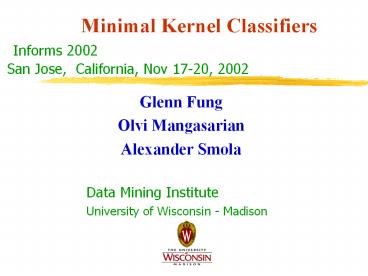Minimal Kernel Classifiers - PowerPoint PPT Presentation
Title:
Minimal Kernel Classifiers
Description:
Quadratic programming (QP) formulation. Linear programming (LP) formulation ... Linear Programming Formulation. Use the 1-norm instead of the 2-norm: min. s.t. ... – PowerPoint PPT presentation
Number of Views:78
Avg rating:3.0/5.0
Title: Minimal Kernel Classifiers
1
Minimal Kernel Classifiers
Informs 2002San Jose, California, Nov 17-20,
2002
- Glenn Fung
- Olvi Mangasarian
- Alexander Smola
Data Mining Institute University of Wisconsin -
Madison
2
Outline of Talk
- Linear Support Vector Machines (SVM)
- Linear separating surface
- Quadratic programming (QP) formulation
- Linear programming (LP) formulation
- Nonlinear Support Vector Machines
- Nonlinear kernel separating surface
- LP formulation
- The Minimal Kernel Classifier (MKC)
- The pound loss function ()
- MKC Algorithm
- Numerical experiments
- Conclusion
3
What is a Support Vector Machine?
- An optimally defined surface
- Linear or nonlinear in the input space
- Linear in a higher dimensional feature space
- Implicitly defined by a kernel function
4
What are Support Vector Machines Used For?
- Classification
- Regression Data Fitting
- Supervised Unsupervised Learning
5
Generalized Support Vector Machines2-Category
Linearly Separable Case
A
A-
6
Support Vector MachinesMaximizing the Margin
between Bounding Planes
A
A-
7
Support Vector Machine FormulationAlgebra of
2-Category Linearly Separable Case
8
QP Support Vector Machine Formulation
9
Support Vector MachinesLinear Programming
Formulation
- Use the 1-norm instead of the 2-norm
- This is equivalent to the following linear
program
10
Nonlinear Kernel LP Formulation
11
The Nonlinear Classifier
- Where K is a nonlinear kernel, e.g.
12
Nonlinear PSVM Spiral Dataset94 Red Dots 94
White Dots
13
Model Simplification
- Why? Minimizes number of kernel functions used.
- Simplifies separating surface.
- Goal 2 Minimize number of active constraints.
- Why? Reduces data dependence.
- Useful for massive incremental classification.
14
Model Simplification Goal 1Simplifying
Separating Surface
15
Model Simplification Goal 2Minimize Data
Dependence
- By KKT conditions
Hence
16
Achieving Model SimplificationMinimal Kernel
Classifier Formulation
17
The (Pound) Loss Function
18
Approximating the Pound Loss Function
19
Minimal Kernel Classifier as a Concave
Minimization Problem
- That can be effectively solved using the finite
- Successive Linearization Algorithm (SLA)
- (Magasarian 1996)
20
Minimal Kernel Algorithm (SLA)
21
Minimal Kernel Algorithm (SLA)
- Each iteration of the algorithm solves a
Linear program. - The algorithm terminates in a finite number of
iterations (typically 5 to 7 iterations). - Solution obtained satisfies the Minimum
Principle necessary optimality condition.
22
(No Transcript)
23
Checkerboard Separating Surface of Kernel
Functions27 of Active Constraints 30 o
24
Numerical ExperimentsResults for six public
datasets
25
Conclusion
- A finite algorithm generating a classifier that
depends on a fraction of input data only. - Important for fast online testing of unseen data,
e.g. fraud or intrusion detection . - Useful for incremental training of massive data
- Overall algorithm consists of solving 5 to 7
LPs. - Kernel data dependence reduced up to 98.8 of
the data used by a standard SVM. - Testing time reduction 98.2.
- MKC testing set correctness comparable to that of
a more complex standard SVM.































